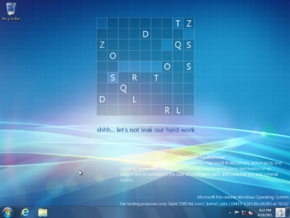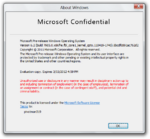Windows 8 build 7985 (fbl_core1_kernel_cptx.110419-1745)
| Build of Windows 8 | |
 | |
| OS family | Windows NT |
|---|---|
| Version number | 6.2 |
| Build number | 7985 |
| Build revision | 0 |
| Architecture | x86 |
| Build lab | fbl_core1_kernel_cptx |
| Compiled on | 2011-04-19 |
| Expiration date | |
| Timebomb | 2012-03-15 (+331 days) |
| About dialog | |
Windows 8 build 7985 (fbl_core1_kernel_cptx.110419-1745) is a Milestone 3 build of Windows 8. The x86 installation media for this build was first shared on 28 June 2022, followed by its public debugging symbols the next day.
Editions and keys[edit | edit source]
| Edition / SKU | Key |
|---|---|
| Starter | 7Q28W-FT9PC-CMMYT-WHMY2-89M6G |
| Home Basic | YGFVB-QTFXQ-3H233-PTWTJ-YRYRV |
| Home Premium | RHPQ2-RMFJH-74XYM-BH4JX-XM76F |
| Professional | HYF8J-CVRMY-CM74G-RPHKF-PW487 |
| Ultimate | D4F6K-QK3RD-TMVMJ-BBMRX-3MBMV |
Changes[edit | edit source]
User interface[edit | edit source]
Redpill-specific changes[edit | edit source]
The main Start screen user interface now includes the "Start header". The Aero theme has also been updated to feature a new design with sharp window corners and flat buttons, making it more resemblant towards the final look of the Windows 8 user interface.
Miscellaneous[edit | edit source]
- The boot screen's status message size has been slightly increased.
- All sample content from Windows 7 has been removed.
Bugfixes[edit | edit source]
Desktop Window Manager[edit | edit source]
The Windows Aero visual style's atlas no longer breaks when attempting to composite blur, and glow effects on caption bar text now renders properly.
Bugs and quirks[edit | edit source]
App tiles[edit | edit source]
Some app names (such as Control Panel, Chess Titans, Defragment and Optimize Drives, etc) may be truncated by normal sized tiles.
Networking bug[edit | edit source]
Enabling networking in hypervisors may cause a 0x133 BSOD.
Advanced Vector Extensions CPU bug[edit | edit source]
This build will not boot on some CPUs with the Advanced Vector Extensions (AVX) instruction set due to a bug where a CPU triple fault occurs immediately after the boot screen is first displayed. A workaround is discussed later in the article. This is the last build to contain this bug.
This problem can also present itself as three bugchecks occurring one after the other, with different error codes overwriting each other on the screen.
Start screen[edit | edit source]
The desktop application tile is treated as if were a native Metro application despite it not being one. As a result, it is possible to "uninstall" the desktop, although nothing will happen if attempted.
Windows Setup[edit | edit source]
- This build must be installed on either an IDE or a SATA hard drive as SCSI disk devices will not be detected properly.
- On some machines, this build may take a significant amount of time to boot.
Boot manager[edit | edit source]
As the kernel/boot loader does not call any code to clear the video buffer early within the boot process, any graphics that are displayed in the boot screen may overlay themselves on top of the last frame sent by the boot manager. This problem is easily observed when loading into a ramdisk boot image or while loading into setup.
Taskbar[edit | edit source]
The Your Look tile has a white trail in the left and white instead of left white up and down.
DWM[edit | edit source]
If DWM is restarted when Redpill is enabled, it causes the Start Screen to glitch while dragging/scrolling.
General[edit | edit source]
Attempting to restart or shutdown in this build will cause a softlock on VMware Workstation versions 15.x and newer releases. It is generally recommended to force an ACPI shutdown by powering off or resetting the virtual machine from the Power drop-down menu.
Logoff error[edit | edit source]
Sometimes, "WinRT UI Window" will prevent the user from logging off.
Compiler[edit | edit source]
This is one of the first builds to be produced using a new compiler. However, the problems surrounding it at that time resulted in the build becoming unbootable on certain hardware, as the boot loader does not properly function on modern x86 CPUs, namely Intel processors with the AVX instruction set and a select number of AMD CPUs. As a result, a CPU triple fault occurs resulting in either a crash on a hypervisor or a reboot on real hardware.
Patching winload.exe to run on Intel processors with AVX[edit | edit source]
In order to properly enable SSE instructions for machines using Intel processor with AVX, the 9th bit in Control Register 4 (CR4) must be turned on. The following code is executed and is located in winload.exe at offset A137:
mov eax, cr4 ; 0f20e0
or eax, 20h ; 83c820 -- Turn on 5th bit, PAE (Physical Address Extension)
mov cr4, eax ; 0f22e0 -- Store it in CR4
mov eax, cr0 ; 0f20c0
or eax, 80000000h ; 0d00000080 -- Enable paging
mov cr0, eax ; 0f22c0
By default the following bits are set in CR0: Protected Mode (PE) (0x00000001), Monitor co-processor (MP) (0x00000002) and Extension type (ET) (0x00000010), with no bits in CR4 set initially, so the need to turn on the 9th SSE bit (i.e. OR with 0x600) should be done, but due to limitation in this piece of code, a rewriting needs to be done and the following approach may be used instead:
mov eax,620h ; b820060000
mov cr4,eax ; 0f22e0
mov eax,80000013h ; b813000080
mov cr0,eax ; 0f22c0
nop ; 90
nop ; 90
nop ; 90
nop ; 90
As a disclaimer, patching winload.exe with these changes will invalidate integrity checks and thus requires Test Mode to be enabled (by setting NoIntegrityChecks in the BCD to on) in order to boot with the patched winload.exe, as well as ownership of the file in both %systemroot%\System32 and %systemroot%\System32\Boot need to be altered in case file replacement was not possible.
Compatibility[edit | edit source]
VMware Workstation[edit | edit source]
For another workaround on the Intel SSE bug that does not involve patching and disabling security checks, the compatibility level must be set to version 7.x or lower in order to boot this build. In addition, the following block of code must be added to the VMX (virtual machine configuration) file in order to allow this build to boot on modern Intel CPUs:
cpuid.0.ebx = "0110:1000:0111:0100:0111:0101:0100:0001"
cpuid.0.ecx = "0100:0100:0100:1101:0100:0001:0110:0011"
cpuid.0.edx = "0110:1001:0111:0100:0110:1110:0110:0101"
cpuid.1.eax = "0000:0000:0000:0001:0000:0110:0111:0001"
The above configuration is mostly not required if the host machine has an AMD processor, and as such only requires the compatibility version to be changed.











